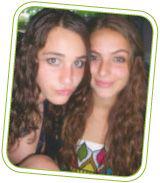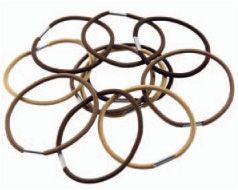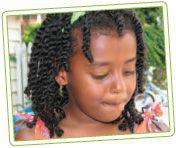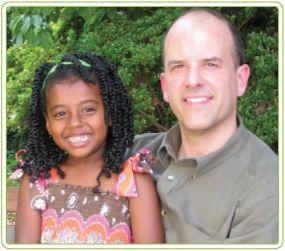B003YL4KS0 EBOK (31 page)
Authors: Lorraine Massey,Michele Bender

CURL CONFESSIONSophie Portnoy
age fourteenWhen my wavy hair turned really curly in sixth and seventh grade, I started straightening it—a task that was totally exhausting. At 11
P.M.
, after studying and homework, I’d spend an hour and a half blowing it dry and flat-ironing it. Then I’d get into bed and try to sleep carefully so I wouldn’t mess up my hard work. By morning, a few curls had escaped so I’d spend more time trying to iron them out.One day, a friend asked me why I straightened my hair. When I told her it was because a boy I had a crush on said he liked it straight, she said, “If he really likes you, he’ll like you whether your hair is straight or curly.” She was right! So I put away my blow-dryer and flat iron and let my curls just be. They looked limp and unhealthy at first, but once I stopped torturing them, they began to look great. And that taught me a valuable lesson: I shouldn’t straighten my hair—or do anything else in life—because of what someone else thinks.
Sophie, left
To put it mildly, puberty is a hormonal, sensitive time. Your child’s face breaks out, his voice cracks, and she can go from smiling to sulking in the span of mere minutes. Then there’s hair that starts to sprout everywhere! Plus, because of puberty, tweens and teens have overactive sebaceous glands, so hair tends to get oily and it can also change from soft and straight to coarse and curly. In fact, I’ve noticed that the hair of some of my young clients can change from one appointment to the next: It can get thicker, wavier, or curlier in a matter of months. Sometimes it’s dry or frizzy, and other times lank and oily. I call these puberty curls or adolescent curls. (There are also times when, just by looking at a young client’s hair, I can tell that puberty is just around the corner.)
My point in telling you this is to put you on alert. If your daughter breaks down sobbing because she can’t manage her hair, she isn’t just moody and dramatic. Her hair may very well be transforming
from seemingly straight or wavy to curls and she has no clue about how to manage it. Your job is to guide her and help her understand and know how to care for her new hair. And if you can do that, at least one aspect of the teen years will be a bit easier.
Once your child is old enough to shower alone, it’s time for a quick course in curly cleansing. The earlier we teach our kids how to cleanse, condition, and style their hair, the better. When they’re little, playfully explain to them what you’re doing when you are cleansing and conditioning their locks during bath time. That way, you’ve already planted the seed for good hair habits.
I knew it was time for some hair coaching with my son when I noticed white blobs of conditioner in his curls when he got out of the shower. I had him put on his swimsuit and head back into the shower, and I coached him from the sidelines: “That’s not enough conditioner. Use more! Move it around with your fingers. O.K., rinse. You missed a spot! Now scrunch!” It may not sound like much fun, but it honestly made a big difference. He now loves his full head of bright red, hydrated, defined curls.
Take the time to teach your curly offspring the cleansing and care methods in this book. Just imagine that if we can teach the next curly generation the best way to care for their hair, we can change the world one gorgeous curl at a time. Then we can concentrate on other things like world peace!
PONYTAIL CAUTIONThe too-tight ponytails that I often see on tweens and teens are a bad idea because they pull on the hairline. This tension can cause the hair to fall out and the hairline to recede. Instead, pull the hair back loosely. Also, if the hair is thick, air-dry it or use a hair dryer with a diffuser before you pull it back. Otherwise, if it’s wet and in a ponytail all day, it can still be damp by evening, and mold and odors can set in.
CURL CONFESSIONClifton Green
professor at Emory UniversityMy adoptive daughter, Miriam, is black, while my wife and I are white. I’m the one who cares for her hair—an experience that has been filled with both joy and frustration and can take over an hour. After all, she’s an active five year old so her hair is easily tangled. It’s taken lots of discovery—we talked with other parents of multicultural kids and read lots of books—and practice. My twists and braids have come a long way but my cornrows still need work. I’ve realized that Miriam’s hair is happier without daily washings, something that would make my hair greasy, and that I can use a fork to make her parts. Sometimes I make twists or braids; other days she wears it loose in what we call “freedom” hair. I think of caring for her hair as laying the groundwork for when she’s older and thinks about her identity as a woman of color. We’re on the wait list to adopt another girl from Ethiopia so I’ll have more chances to practice my skills!
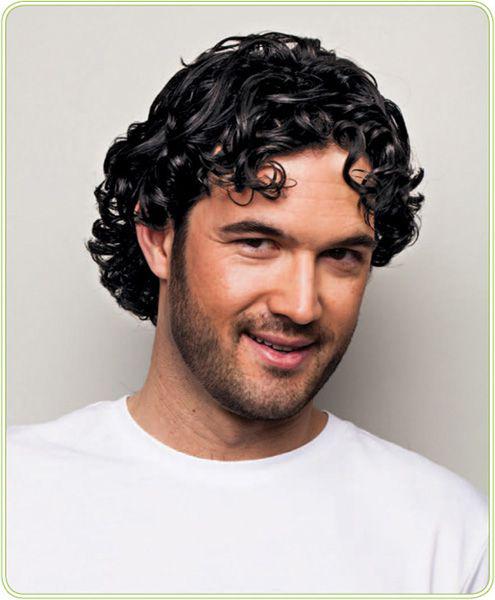
Since I wrote the first version of
Curly Girl
, I’ve been surprised that I’ve been hearing from the many curly guys out there. Sure, I knew there were many, many men with gorgeous curls, waves, and s’waves, but who knew they would pick up a book called
Curly Girl
and then take the time to write to the author? Well, they did. In droves! And they asked for their own chapter, so here it is.
Curly guys can simply follow the same routines as curly girls. But I know that most guys don’t want to spend as much time on their hair as women do. So, I’m giving you a down-and-dirty routine with only the essential steps. If you are a curly guy, and you currently cleanse your hair and apply a styling product, your new curly hair routine won’t take much longer than what you’re doing now.
Curls are a blessing not in disguise.
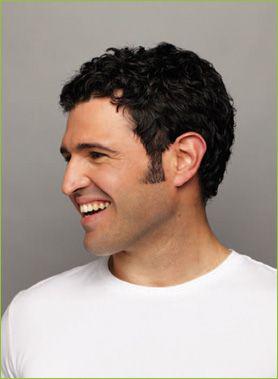
What’s important is how and with what you cleanse your hair and the styling products you apply.
A lot of men use shampoo to clean their hair. But if you’re a curly guy, what you need to use is either a 100-percent sulfate-free cleanser or a botanical conditioner to cleanse your hair. Most days, that’s all you’ll need to make your hair look great. The sulfate-free feature is key, because the chemicals in shampoos are damaging and drying to your hair and scalp. Since men are prone to rapid hair thinning and loss after the age of thirty, the last thing you want to do is subject your scalp and hair to chemicals that will only speed up the process.
Anecdotal evidence from many of our male clients and Devachan experts indicates that quitting their shampoo habit helped with their hair thinning and hair loss. Edward Fagley, Deva Color expert, was losing his hair before he came to work at the salon almost thirteen years ago. “I admit that I thought Lorraine was crazy when she suggested that clients never use shampoo,” says Edward. “But once I stopped shampooing, I stopped losing my hair. The hair that I
do
have looks and feels fuller because the products I use fill it with moisture and give it natural volume.” Going naturally curly also helps conceal thinning hair, because curls’ spherical shapes fill in space, making hair appear thicker than it really is.
Men often complain about dandruff. If you are one of them, you may be mistaking a simple dry scalp caused by harsh detergent-laden shampoos for a medical condition. Using shampoo to get rid of this supposed dandruff only clogs the pores, which turn into flakes, starting a vicious circle. Once you stop sudsing up your hair with detergents, your scalp will be healthier.
